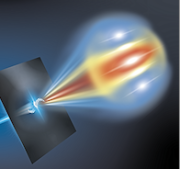日本語で読みたい方は、 google chromeで開き、
画面上で右クリックをして、「日本語に翻訳」をクリックしてください
HZDR-Team presents new diagnostic tool for laser-plasma accelerator
They are seen as highly promising research tools: laser-plasma accelerators take up less space than conventional facilities, which are sometimes kilometers long. Such compact particle sources can accelerate electron bunches efficiently, enabling x-ray lasers that fit in the basement of a university institute. But there are a few challenges to be met: in order to produce UV or x-ray light, the electron bunches generated by a laser-plasma accelerator must be very finely bundled and have defined properties. To date, it has been difficult to even measure these bunches precisely. Now, a team at the Helmholtz-Zentrum Dresden-Rossendorf (HZDR) has developed a novel measuring method which should help to drive the development of laser-plasma acceleration, as the group explains in the journal Nature Photonics (DOI:10.1038/s41566-024-01475-2).

A structured beam of electron beamlets (modulated group of white spheres) passes through a metallic foil from left to right creating coherent optical transition radiation (COTR). This radiation encodes unique beam structure information at each wavelength, as depicted by the different red, yellow and blue radiation patterns.
Source: HZDR / Blaurock
The free electron laser (FEL) is an interesting application for state-of-the-art laser-plasma accelerators. Here, electron bunches fly through a so-called undulator at nearly the speed of light. This array of magnets forces the particles onto slalom paths, making them emit strong, laser-like x-ray or UV flashes, which can be utilized to track extremely fast processes like chemical reactions that take place in quadrillionths of a second.
Compact and cost-effective
There are now several of these research machines, including the European XFEL in Hamburg. They are based on conventional linear accelerators, some of which are several kilometers long. But, so far, these facilities are rare and thus the available beamtime is limited. If FELs could be constructed on the basis of laser-plasma accelerators, the facilities could be built so compactly and cost-effectively that a university institute, for instance, would be able to afford one. The technology would thus become available to far more research teams than at present.
Initial successes have already been achieved: since 2021, three research groups have managed to demonstrate that an FEL based on plasma accelerators can be implemented – a team in Shanghai, China, a group in Frascati, near Rome, and a team working with the physicist Dr. Arie Irman at HZDR’s Institute for Radiation Physics. In a review article in the journal Nature Photonics, those involved summarize the current state of development and itemize the outstanding research questions. “Among other things, we have to improve the quality and stability of the accelerated electron bunches and minimize the distribution of the electrons’ energy within the bunches,” explains Irman, one of the authors of the paper. “But it is also important to develop new diagnostic methods in order to investigate the processes in a laser-plasma accelerator more precisely.”
Electron bunches traverse foil
This is where the new HZDR project comes in: Dr. Maxwell LaBerge, a postdoc in Irman’s Team, has developed a measuring procedure that allows scientists to analyze in detail extremely short electron bunches measuring just a few micrometers. LaBerge explains the principle: “We shoot the electron bunches, almost at the speed of light, from the plasma accelerator onto a thin metal foil. This sets the electrons on the surface of the foil in motion.” As a result, these electrons send a signal – rather like a transmitting antenna – that can be detected by sensors. “Using this signal, we can precisely reconstruct what the electron bunches that have traversed the foil look like,” says LaBerge, describing the process, the technical term for which is Coherent Optical Transition Radiation (COTR).
HZDR’s experts have used their new measuring method to explore different ways of injecting the electrons into the plasma bubble. Arie Irman describes the result: “We’ve been able to ascertain that different injection methods produce quite different forms of electron bunches, which shows that the new method can help to control the form and structure of the electron bunches much more precisely.” And the better the control over the speedy electron bunches, the brighter and more stable the light they produce in an FEL.
Publications:
M. LaBerge, B. Bowers, Y. Chang, J. Couperus Cabadağ, A. Debus, A. Hannasch, R. Pausch, S. Schöbel, J. Tiebel, P. Ufer, A. Willmann, O. Zarini, R. Zgadzaj, A. Lumpkin, U. Schramm, A. Irman, M. C. Downer: Revealing the 3D structure of microbunched plasma-wakefield-accelerated electron beams, in Nature Photonics, 2024 (DOI: 10.1038/s41566-024-01475-2)
M. Galletti, R. Assmann, M.E. Couprie, M. Ferrario, L. Giannessi, A. Irman, R. Pompili, W. Wang: Prospects for Free Electron Lasers powered by plasma-wakefield accelerated beams, in Nature Photonics, 2024 (DOI:10.1038/s41566-024-01474-3)
Additional information:
Dr. Arie Irman | Dr. Maxwell LaBerge
Institute of Radiation Physics at HZDR
Phone: +49 351 260 3043 | +49 351 260 3930
Email: a.irman@hzdr.de | m.laberge@hzdr.de
Medienkontakt:
Simon Schmitt | Head
Communications and Media Relations at HZDR
Phone: +49 351 260 3400 | Mobile: +49 175 874 2865 | Email: s.schmitt@hzdr.de
出典:
https://www.hzdr.de/db/Cms?pOid=72802&pNid=3438
ご参考:
(株)光響が提供する製品・サービス情報:
・特殊レーザー光源 関連製品
記事の追加及び削除:
記事の追加あるいは削除を希望される場合、お手数ではございますが、
以下窓口までご連絡ください。
info@symphotony.com
この情報へのアクセスはメンバーに限定されています。ログインしてください。メンバー登録は下記リンクをクリックしてください。

